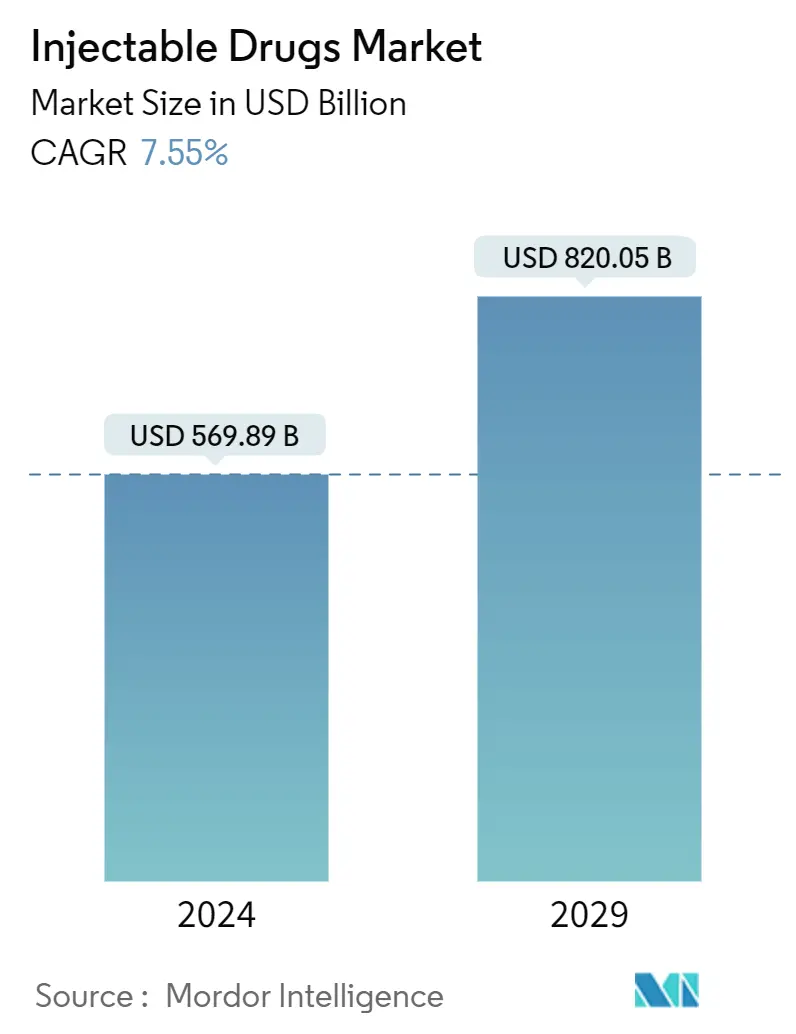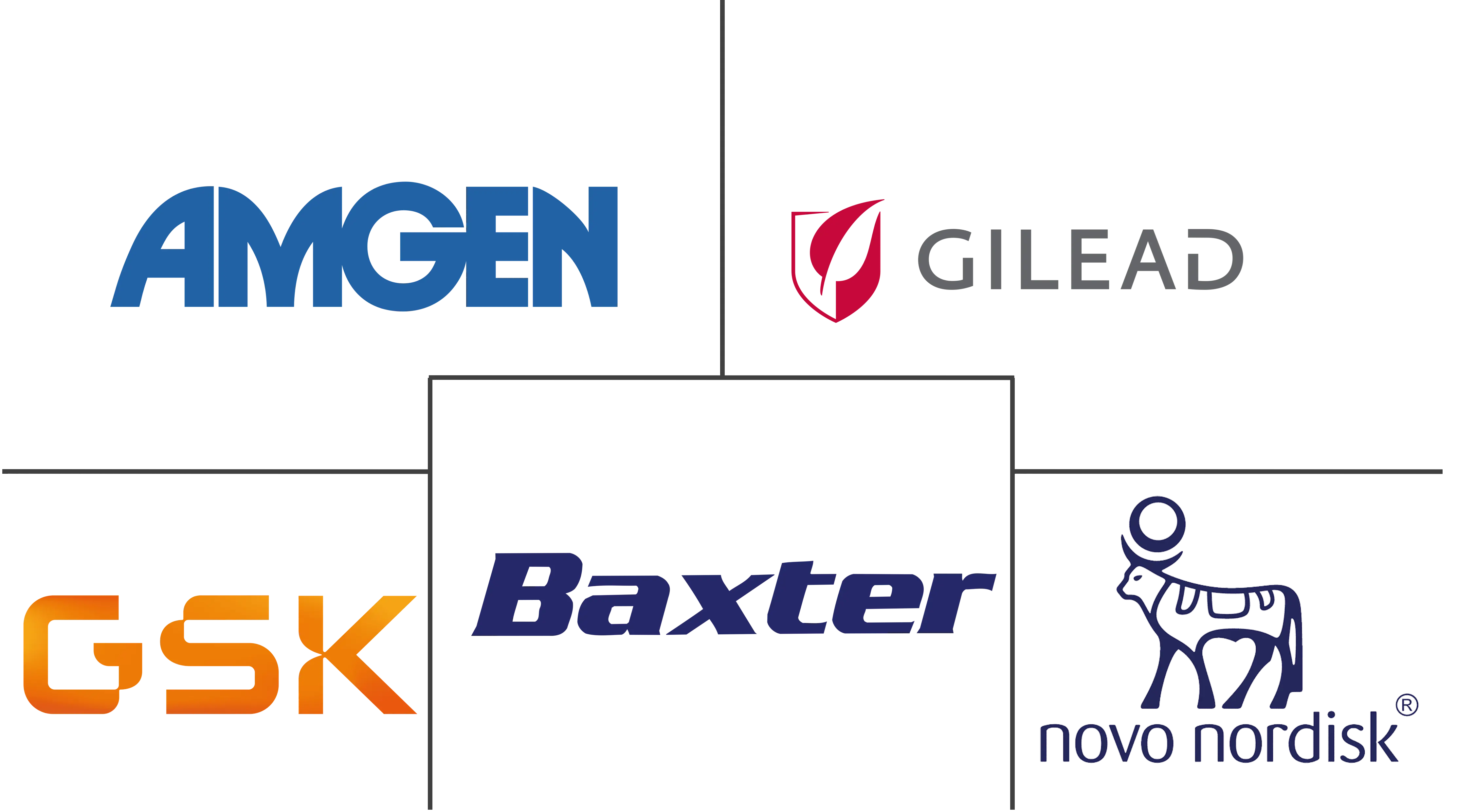Market Size of Injectable Drugs Industry

| Study Period | 2019 - 2029 |
| Market Size (2024) | USD 569.89 Billion |
| Market Size (2029) | USD 820.05 Billion |
| CAGR (2024 - 2029) | 7.55 % |
| Fastest Growing Market | Asia-Pacific |
| Largest Market | North America |
Major Players
*Disclaimer: Major Players sorted in no particular order |
Injectable Drugs Market Analysis
The Injectable Drugs Market size is estimated at USD 569.89 billion in 2024, and is expected to reach USD 820.05 billion by 2029, growing at a CAGR of 7.55% during the forecast period (2024-2029).
Megatrends Driving Market Growth: The injectable drugs market is undergoing substantial growth, driven by key megatrends. Chronic disease prevalence is rising globally, necessitating more effective, targeted treatments that injectable drugs can offer. Biotechnological advancements are further supporting the development of sophisticated, potent injectable formulations. Additionally, the shift toward personalized medicine is increasing the demand for specialized injectable therapeutic solutions, allowing for patient-specific treatments.
Rising R&D Focus on Biotechnology-Engineered Anti-Cancer Drugs: A sharp focus on R&D in biotechnology-engineered injectable oncology drugs is evident within the biopharmaceutical industry. This is in response to the growing global cancer burden and the potential for these drugs to deliver more effective treatments. Collaborative efforts among pharmaceutical companies, academic institutions, and government agencies are leading to breakthroughs, particularly in injectable biologics for cancer therapy. These injectable formulations offer targeted drug delivery, improving treatment outcomes.
Rapid Growth in Pre-filled Syringes for Biologics: Pre-filled syringes are becoming the preferred delivery system for injectable biologics due to their ease of use, increased dose accuracy, and lower risk of contamination. The rising adoption of self-injecting drug delivery systems is contributing to the growth of this segment. Pre-filled syringes, particularly for complex biologics, are addressing challenges related to drug stability and ease of administration, thus enhancing injectable drugs market growth.
Increased Outsourcing Across the Value Chain: Outsourcing in the injectable drugs manufacturing process is growing, with pharmaceutical companies increasingly relying on contract research organizations (CROs) and logistics providers. This trend enhances production efficiency and allows companies to focus on core operations while scaling the supply of injectable pharmaceuticals. The strategy is especially pronounced in emerging markets with cost-efficient skilled labor, facilitating the more rapid distribution of injectable drugs worldwide.
Injectable Drugs Industry Segmentation
Injectable drugs are introduced into the body with a syringe and needle. These drugs are used to treat various diseases and disorders. The injectable drugs market is gaining importance in hospitals and clinics, with an increasing number of biologics, antibody-drug conjugates, monoclonal antibodies in development, and several injectable drugs under clinical trials globally.
The injectable drugs market is segmented by molecule type, drug class, application, and geography. By molecule type, the market is segmented into small molecules and large molecules. By drug class, the market is segmented into blood factors, cytokines, peptide hormones, immunoglobulin, monoclonal antibodies (mAbs), insulin, and other drug classes. By application, the market is segmented into oncology, neurology, cardiovascular diseases, autoimmune diseases, infectious diseases, pain, and other applications. By geography, the market is segmented into North America, Europe, Asia-Pacific, the Middle East and Africa, and South America. For each segment, the report offers market size and forecasts in terms of value (USD).
| By Molecule Type | |
| Small Molecule | |
| Large Molecule |
| By Drug Class | |
| Blood Factors | |
| Cytokines | |
| Peptide Hormone | |
| Immunoglobulin | |
| Monoclonal Antibodies (mAbs) | |
| Insulin | |
| Other Drug Classes |
| By Application | |
| Oncology | |
| Neurology | |
| Cardiovascular Diseases | |
| Autoimmune Diseases | |
| Infectious Diseases | |
| Pain | |
| Other Applications |
| By Geography | ||||||||
| ||||||||
| ||||||||
| ||||||||
| ||||||||
|
Injectable Drugs Market Size Summary
The injectable drugs market is poised for significant growth over the forecast period, driven by a combination of factors including the rising prevalence of chronic diseases such as cancer, diabetes, and cardiovascular conditions. The market's expansion is further supported by increased research and development efforts focused on biotechnology-engineered anti-cancer drugs and the rapid adoption of pre-filled syringes for biologics. The COVID-19 pandemic initially spurred market growth as companies accelerated the development and distribution of vaccines, primarily administered via injectables. As pandemic-related restrictions eased, the market continued to benefit from resumed activities and heightened demand for effective therapeutics. The market's trajectory is also influenced by the growing focus on developing new therapeutic classes, which is expected to enhance the adoption and availability of injectable drugs.
North America is anticipated to maintain its dominance in the injectable drugs market, bolstered by a robust healthcare infrastructure, a high prevalence of chronic diseases, and the presence of major industry players. The region's growth is further fueled by numerous novel product launches and substantial investments in research and development. The increasing geriatric population and the rising number of diabetes cases in the United States are key factors driving demand for injectable drugs. The market is moderately competitive, with key players like GlaxoSmithKline, Baxter International, and Amgen actively expanding their production capacities and forming strategic partnerships to enhance manufacturing and distribution efficiencies. These dynamics collectively contribute to the market's expected growth trajectory over the forecast period.
Injectable Drugs Market Size - Table of Contents
-
1. MARKET DYNAMICS
-
1.1 Market Overview
-
1.2 Market Drivers
-
1.2.1 Rising R&D Focus on the Development of Biotechnology-engineered Anti-cancer Drugs
-
1.2.2 Rapid Growth in the Usage of Pre-filled Syringes for Biologics
-
1.2.3 Increased Outsourcing Activities Across Value Chain Expected to Boost Supply of Injectable Products
-
-
1.3 Market Restraints
-
1.3.1 High Expenses Associated with Inventory Management
-
1.3.2 Availability of Alternate Drug Delivery Methods
-
-
1.4 Porter's Five Forces Analysis
-
1.4.1 Threat of New Entrants
-
1.4.2 Bargaining Power of Buyers/Consumers
-
1.4.3 Bargaining Power of Suppliers
-
1.4.4 Threat of Substitute Products
-
1.4.5 Intensity of Competitive Rivalry
-
-
-
2. MARKET SEGMENTATION (Market Size by Value - USD)
-
2.1 By Molecule Type
-
2.1.1 Small Molecule
-
2.1.2 Large Molecule
-
-
2.2 By Drug Class
-
2.2.1 Blood Factors
-
2.2.2 Cytokines
-
2.2.3 Peptide Hormone
-
2.2.4 Immunoglobulin
-
2.2.5 Monoclonal Antibodies (mAbs)
-
2.2.6 Insulin
-
2.2.7 Other Drug Classes
-
-
2.3 By Application
-
2.3.1 Oncology
-
2.3.2 Neurology
-
2.3.3 Cardiovascular Diseases
-
2.3.4 Autoimmune Diseases
-
2.3.5 Infectious Diseases
-
2.3.6 Pain
-
2.3.7 Other Applications
-
-
2.4 By Geography
-
2.4.1 North America
-
2.4.1.1 United States
-
2.4.1.2 Canada
-
2.4.1.3 Mexico
-
-
2.4.2 Europe
-
2.4.2.1 Germany
-
2.4.2.2 United Kingdom
-
2.4.2.3 France
-
2.4.2.4 Italy
-
2.4.2.5 Spain
-
2.4.2.6 Rest of Europe
-
-
2.4.3 Asia-Pacific
-
2.4.3.1 China
-
2.4.3.2 Japan
-
2.4.3.3 India
-
2.4.3.4 Australia
-
2.4.3.5 South Korea
-
2.4.3.6 Rest of Asia-Pacific
-
-
2.4.4 Middle East and Africa
-
2.4.4.1 GCC
-
2.4.4.2 South Africa
-
2.4.4.3 Rest of Middle East and Africa
-
-
2.4.5 South America
-
2.4.5.1 Brazil
-
2.4.5.2 Argentina
-
2.4.5.3 Rest of South America
-
-
-
Injectable Drugs Market Size FAQs
How big is the Injectable Drugs Market?
The Injectable Drugs Market size is expected to reach USD 569.89 billion in 2024 and grow at a CAGR of 7.55% to reach USD 820.05 billion by 2029.
What is the current Injectable Drugs Market size?
In 2024, the Injectable Drugs Market size is expected to reach USD 569.89 billion.

